The human iris contains a remarkable wealth of information about our overall health and wellbeing. The intricate patterns, colors, and structures visible in the Iris Texture represent a unique biological signature that many practitioners believe can reveal insights about our physical condition. With advances in iridology equipment and analysis techniques, these patterns can now be studied with unprecedented precision. This article explores the fascinating world of iris analysis, its scientific foundations, and how modern technology is enhancing our ability to interpret what our eyes may be telling us about our health.
Iris Texture and Its Formation
The iris is the colored portion of the eye that surrounds the pupil. Its primary function is to control the amount of light entering the eye by adjusting the size of the pupil. However, the iris is much more than just a functional component of vision – it’s a complex structure with unique characteristics.
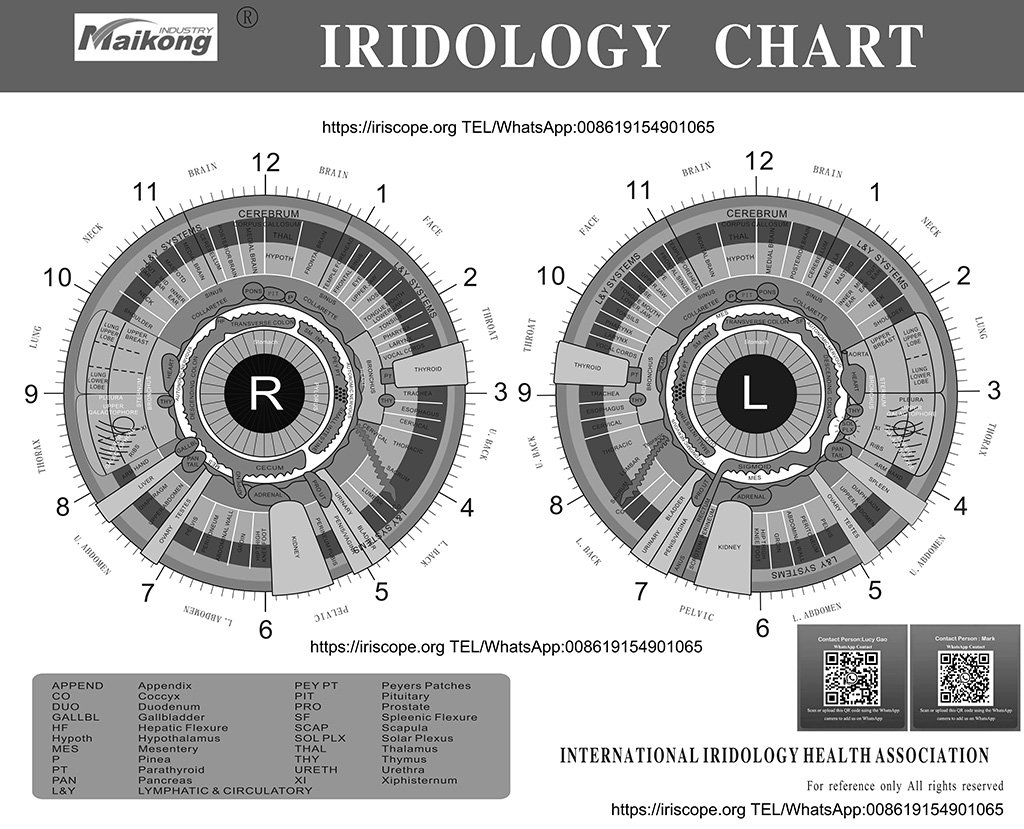

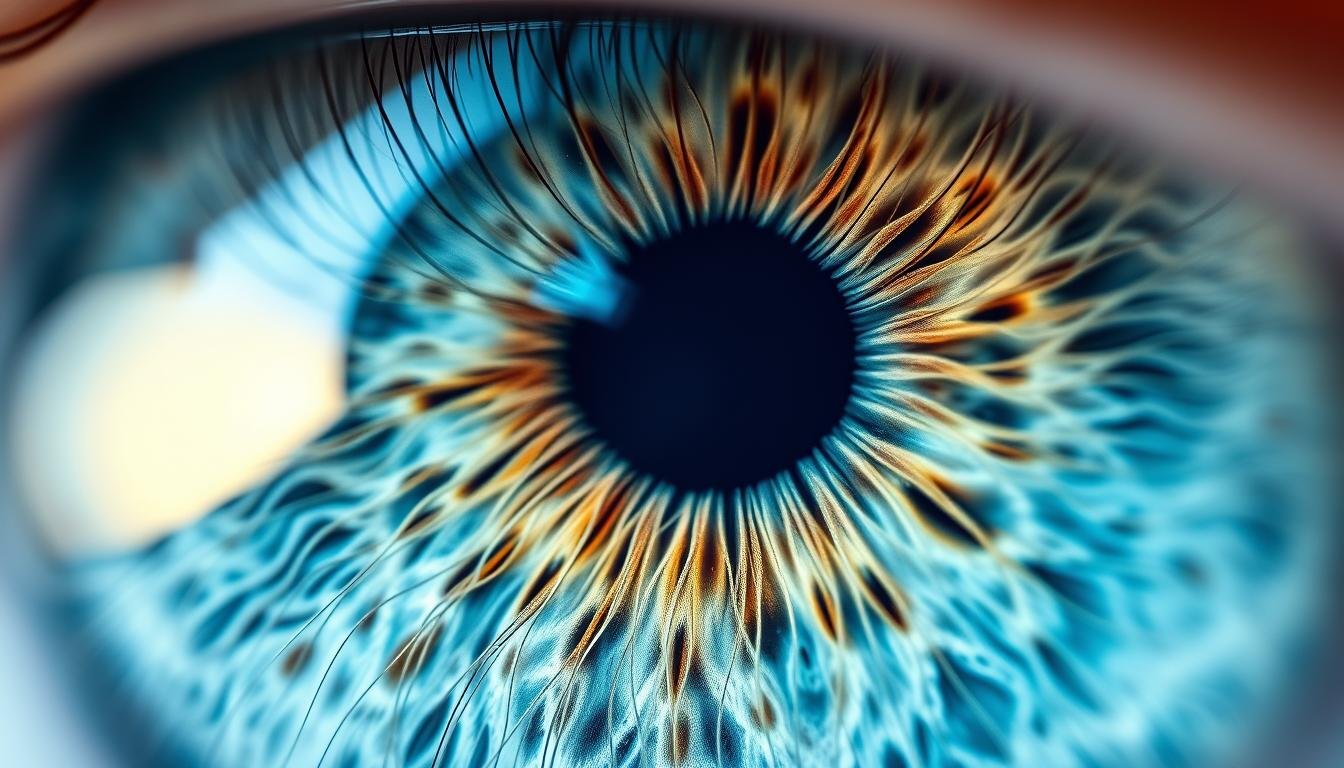
Detailed view of human iris showing complex texture patterns. www.iriscope.org
How Iris Texture Develops
The development of iris texture begins during fetal development and continues through early childhood. By the time a child reaches about three years of age, the iris patterns are fully formed and remain relatively stable throughout life, with only minor changes occurring due to aging or health conditions.
The unique texture of the iris forms through several developmental processes:
- Embryonic mesoderm and ectoderm layers form the iris stroma and pigment epithelium
- Collagen and elastic fibers create the distinctive patterns visible in the iris
- Melanin distribution determines the color and certain aspects of the texture
- Genetic factors influence the overall structure and pattern formation
These developmental processes result in an iris that is completely unique to each individual – even identical twins have different iris patterns. This uniqueness is why iris recognition is used as a biometric identifier in security applications.
Anatomical Components of Iris Structure
The iris consists of several layers and components that contribute to its overall texture:
Anterior Border Layer
This is the front surface of the iris that creates the visible texture. It contains a network of fibroblasts and collagen that form the distinctive patterns we can observe.
Stroma
The middle layer of the iris contains blood vessels, pigment cells, and a loose collagen framework. The arrangement of these elements contributes significantly to the visible texture patterns.
Iris Muscles
The dilator and sphincter muscles control pupil size and create some of the radial and circular patterns visible in the iris.
Posterior Pigment Epithelium
This back layer contains pigmented cells that prevent light from passing through the iris. While not directly visible, it influences the overall appearance of the iris.
These anatomical components work together to create the complex and unique iris texture that can be analyzed for both identification purposes and, according to iridology practitioners, health assessment.
Different Types of Iris Patterns and Textures
Iris patterns vary widely among individuals, but researchers and iridologists have identified several common structural elements and pattern types that appear across populations.
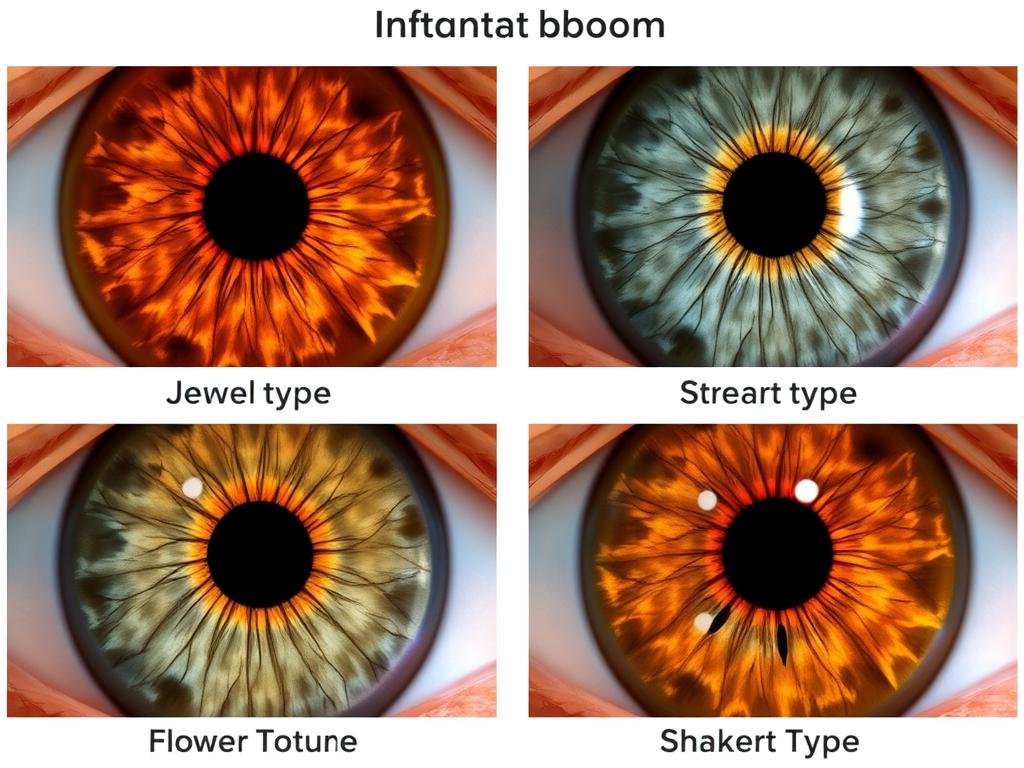
The four main iris pattern types: Jewel, Flower, Stream, and Shaker. www.iriscope.org
Common Iris Texture Elements
Regardless of eye color or pattern type, certain structural elements are present in all irises:
| Texture Element |
Descrição |
Significance in Iridology |
| Collarette |
The jagged or scalloped boundary between the pupillary and ciliary zones |
Represents the digestive system in iridology charts |
| Criptas |
Diamond-shaped openings or depressions in the iris fiber |
May indicate inherent weaknesses in specific organs |
| Sulcos radiais |
Lines radiating outward from the pupil |
Associated with circulation and nerve pathways |
| Manchas de pigmento |
Dark spots or freckles on the iris surface |
May indicate toxin accumulation or lesions |
| Lacunas |
Closed, usually darker areas resembling lakes |
Often associated with enclosed toxic conditions |
| Rings |
Circular bands that appear around the iris |
May indicate stress, nervous tension, or autonomic imbalances |
The Four Main Iris Pattern Types
According to the Rayid Model of iris interpretation, there are four primary iris pattern types, each associated with different personality traits and health tendencies:
Jewel Type
Characterized by dot-like pigments or “jewels” within the iris fiber. People with this pattern type are often analytical, logical, and mentally oriented.
Flower Type
Features rounded openings resembling flower petals. Associated with emotional, feeling-oriented personalities who are expressive and intuitive.
Stream Type
Contains straight lines or streaks radiating from the pupil. Often linked to kinesthetic, action-oriented individuals who are sensitive and intuitive.
Shaker Type
Combines elements of both jewel and flower patterns. Associated with dynamic, driven personalities with a tendency toward extremes.
It’s important to note that most people have a combination of these pattern types, with one usually being predominant. Pure types are relatively rare, and most irises display a mixture of characteristics.
Variations in Iris Color and Texture
The color of the iris is determined by the amount and distribution of melanin in the iris stroma, while the texture is primarily formed by the arrangement of collagen fibers. These two aspects interact to create the visible patterns we observe.
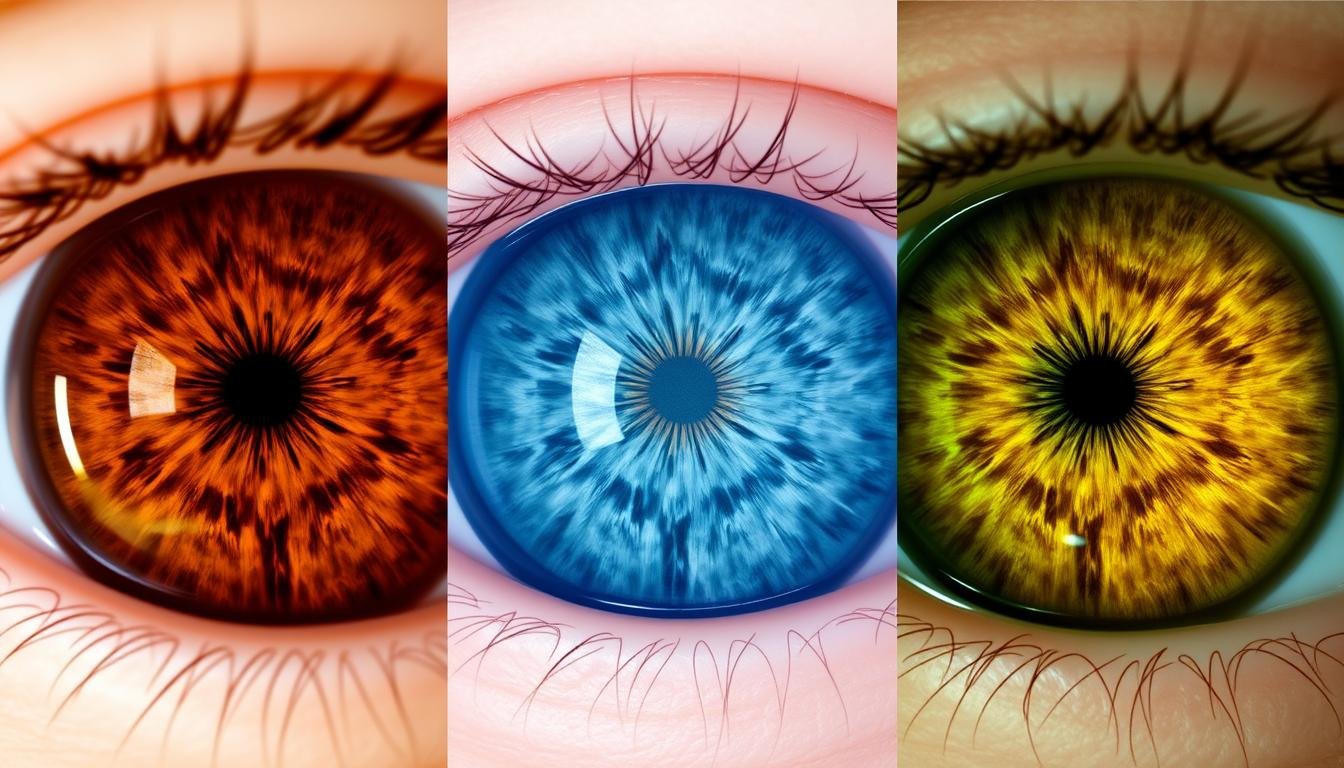
Different colored irises showing similar structural patterns despite color variation. www.iriscope.org
While iris color can range from light blue to dark brown, the underlying texture patterns are independent of color. This means that the same types of structural elements (crypts, furrows, etc.) can be found in irises of any color, though they may be more difficult to observe in darker irises without specialized equipment.
The Connection Between Iris Texture and Health
The practice of iridology is based on the premise that the iris reflects the condition of various body systems and organs. While conventional medicine does not widely accept all aspects of iridology, there are some established connections between certain iris characteristics and health conditions.

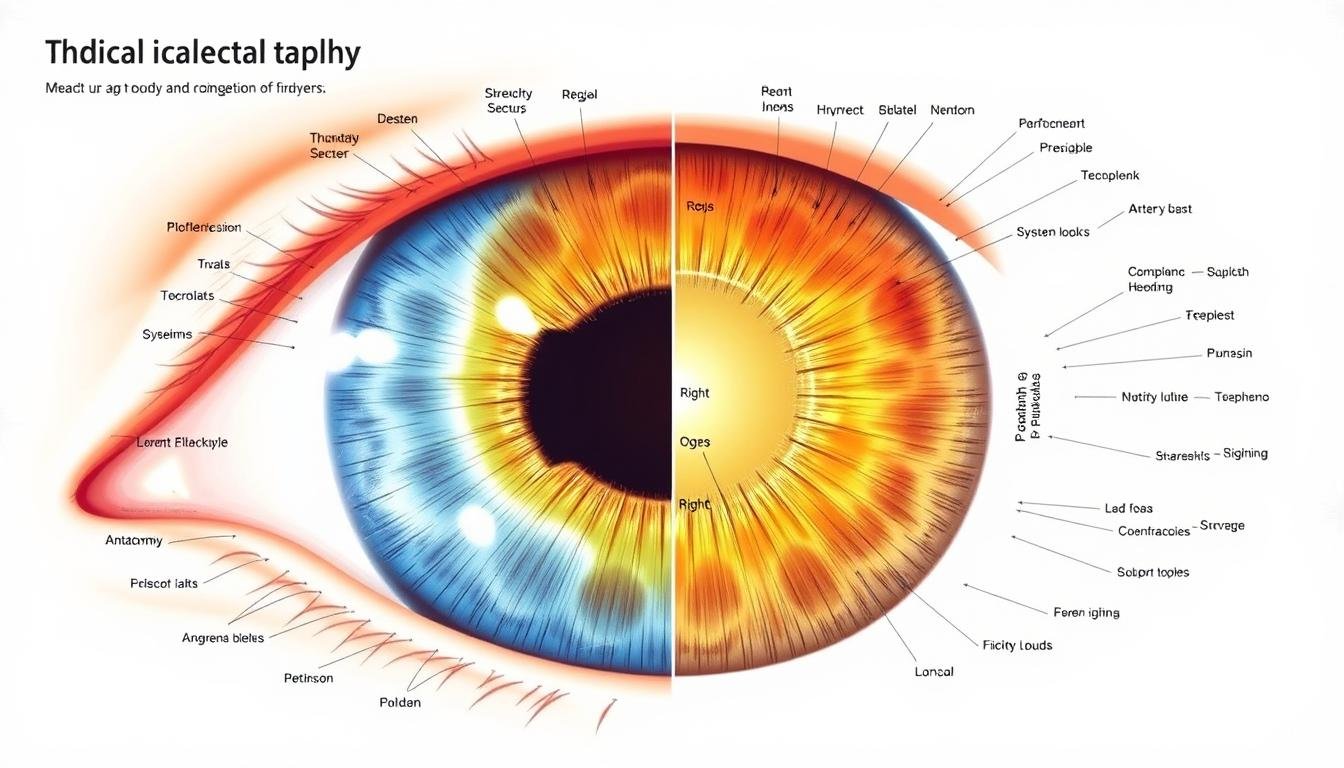
Iridology chart mapping different body systems to regions of the iris. www.iriscope.org
Established Medical Connections
Several iris characteristics have been linked to specific medical conditions through scientific research:
- Brushfield Spots – White spots arranged in a ring around the iris that are associated with Down syndrome
- Wolfflin Nodules – Small, elevated nodules on the iris surface that may be linked to neurofibromatosis
- Iris Nevi – Pigmented lesions that should be monitored for changes that could indicate melanoma
- Heterocromia – Different colored irises or sections within an iris that can be associated with certain genetic conditions
- Iris Atrophy – Thinning of the iris tissue that may indicate glaucoma or other eye conditions
Iridology Principles and Health Assessment
Iridology practitioners believe that the iris can reveal much more detailed information about health status through careful analysis of its texture and patterns. According to iridology theory:
Topographical Correspondence
Different areas of the iris correspond to different organs and body systems, creating a map that can be used to identify areas of concern.
Avaliação Constitucional
The basic iris structure indicates inherited strengths and weaknesses that may predispose an individual to certain health conditions.
Acute vs. Chronic Signs
Different markings may indicate acute inflammation versus chronic degenerative conditions, helping to assess the stage of a health issue.
Healing Signs
Certain changes in iris texture may indicate healing processes or improvement in previously compromised areas.
Nota importante: While iridology can provide interesting insights, it should be considered complementary to, not a replacement for, conventional medical diagnosis. Always consult with qualified healthcare professionals for medical concerns.
Scientific Basis of Iridology and Iris Texture Analysis
The scientific understanding of iris analysis exists on a spectrum, with some aspects well-established in medical science and others still considered alternative or complementary approaches.
Research and Evidence
Scientific research on iridology has produced mixed results:
Evidência de apoio
- Genetic studies confirm that iris patterns are highly heritable and stable
- Some correlations between specific iris signs and certain health conditions have been documented
- Advanced imaging technology has improved the ability to detect subtle changes in iris structure
- Animal studies have shown some reflexive connections between internal organs and iris changes
Limitações e críticas
- Many controlled studies have failed to show that iridologists can consistently diagnose diseases
- The proposed mechanisms for how internal conditions would affect iris structure remain unclear
- Standardization of analysis methods and interpretation varies widely among practitioners
- Conventional medicine has not adopted iridology as a diagnostic method
Neurological Connections
Some scientific basis for iridology may be found in the neurological connections between the iris and the rest of the body:
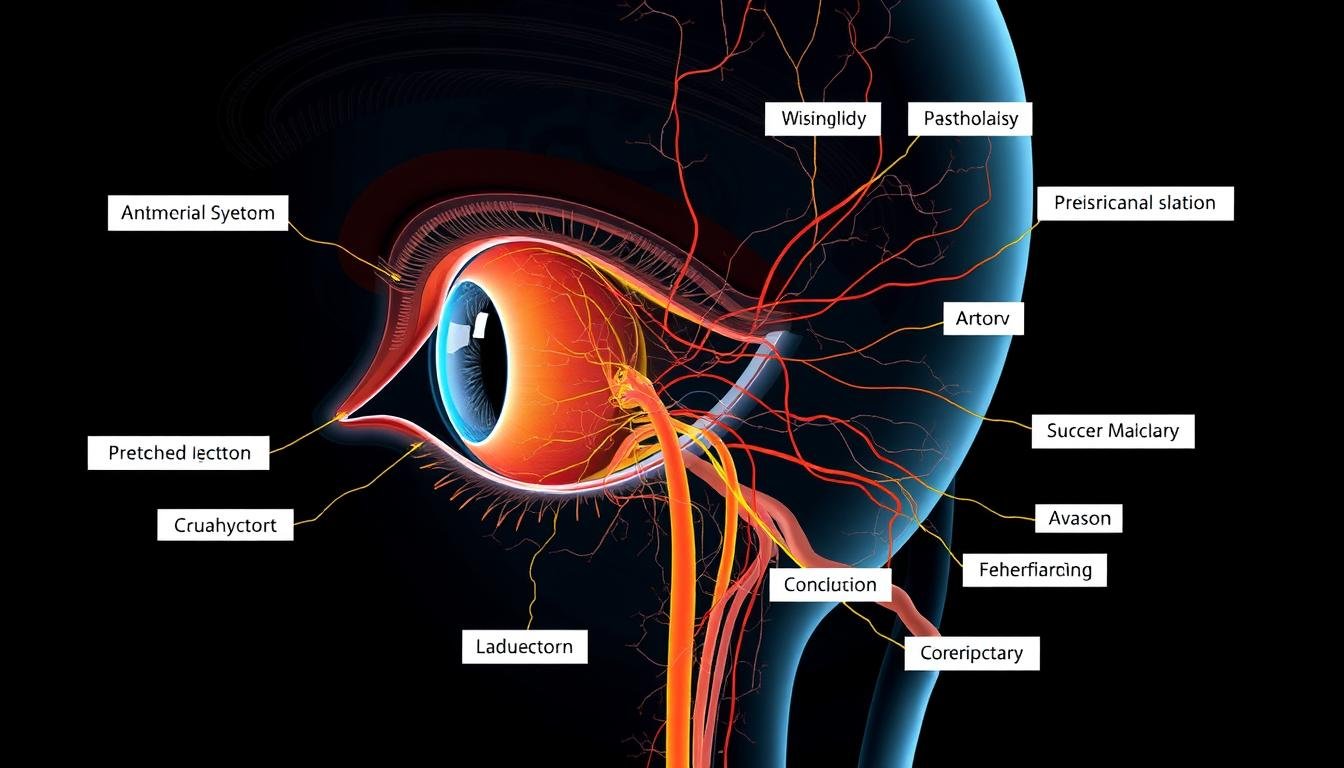
Neurological pathways connecting the iris to various body systems. www.iriscope.org
The iris is innervated by branches of the oculomotor nerve (cranial nerve III) and the sympathetic nervous system. These connections provide pathways through which systemic conditions might theoretically influence iris appearance:
- The autonomic nervous system connects the iris to many internal organs
- Inflammatory mediators circulating in the bloodstream can affect iris tissue
- Hormonal changes may influence iris muscle tone and pigmentation
- Toxins circulating in the body could potentially accumulate in or affect iris tissue
While these connections exist, the specific mechanisms by which they might produce the detailed correspondences claimed in iridology remain an area of ongoing research and debate.
Health Conditions Reflected in Iris Texture Changes
According to iridology practitioners, various changes in iris texture and appearance may correspond to specific health conditions or tendencies. While these associations should be interpreted with caution, they represent common observations in iridology practice.
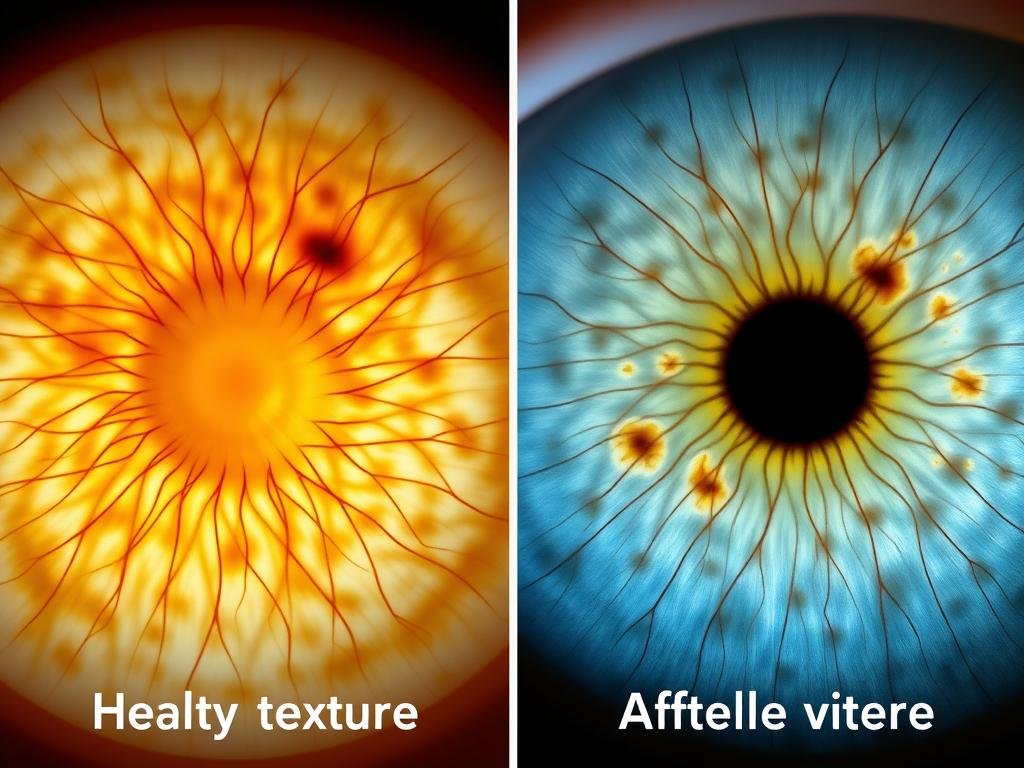
Comparison between healthy iris texture (left) and iris showing potential health indicators (right). www.iriscope.org
Common Iris Signs and Their Potential Health Implications
| Sinal de íris |
Aparência |
Indicação potencial de saúde |
| Anéis nervosos |
Circular rings around the iris |
Stress, nervous tension, autonomic nervous system imbalance |
| Rosário linfático |
White cloud-like formations around the outer iris |
Lymphatic system congestion, poor waste elimination |
| RIM SCURF |
Dark ring at the outer edge of the iris |
Skin elimination issues, respiratory system concerns |
| Raio solar |
Spoke-like lines radiating outward |
Toxin elimination pathways, potential bowel issues |
| Manchas de pigmento |
Dark spots on the iris surface |
Possible toxin accumulation or organ stress |
| Lacunas |
Enclosed darker areas in the iris |
Potential tissue damage or lesions in corresponding organs |
| Psoric Spots |
Small, bright white spots |
Possible inflammatory conditions or hypersensitivities |
Systemic Health Conditions and Iris Correlations
Iridology practitioners often look for specific patterns that may indicate tendencies toward certain systemic health conditions:
Sistema digestivo
The collarette area (inner iris ring) is associated with digestive function. Irregularities, darkening, or structural changes in this area may indicate digestive weaknesses, food sensitivities, or gastrointestinal inflammation.
Sistema cardiovascular
Certain areas of the iris correspond to heart and circulation. Discolorations, markings, or structural changes in these zones may suggest cardiovascular stress, circulation issues, or blood pressure tendencies.
Nervous System
Nerve rings (circular lines around the iris) and specific markings in nerve-related zones may indicate stress levels, nervous system balance, and potential neurological sensitivities.
Professional Assessment: Accurate interpretation of iris signs requires professional training and specialized equipment. MAIKONG’s professional iridology cameras and software can help practitioners capture and analyze iris details with precision.
Professional Analysis of Iris Texture
Professional iris analysis requires both specialized knowledge and advanced equipment to capture and interpret the subtle details of iris texture accurately.

Professional iridologist using MAIKONG iriscope equipment for detailed iris analysis. www.iriscope.org
Equipment Used for Iris Texture Analysis
Modern iridology relies on specialized equipment to capture high-resolution images of the iris:
Iriscópio
A specialized microscope designed specifically for examining the iris. MAIKONG iriscopes feature high-resolution optics and adjustable magnification to capture even the finest details of iris texture.
Câmera de iridologia
Digital cameras with macro capabilities and specialized lighting designed to photograph the iris. MAIKONG iridology cameras offer precise focus control and optimal illumination for accurate color reproduction.
Software de iridologia
Computer programs that help analyze iris images, overlay iridology charts, and document findings. MAIKONG iridology software includes advanced image processing and analysis tools for comprehensive assessment.
The Professional Analysis Process
A comprehensive iris analysis typically follows these steps:
- Captura de imagem – High-resolution photographs are taken of both irises under controlled lighting conditions
- Avaliação inicial – Overall iris structure, color, and constitutional type are evaluated
- Detailed Analysis – Specific markings, patterns, and signs are identified and documented
- Chart Correlation – Findings are correlated with iridology charts to identify potential areas of concern
- Interpretação – The practitioner interprets the findings in the context of the client’s health history and symptoms
- Recommendations – Personalized health recommendations are provided based on the analysis
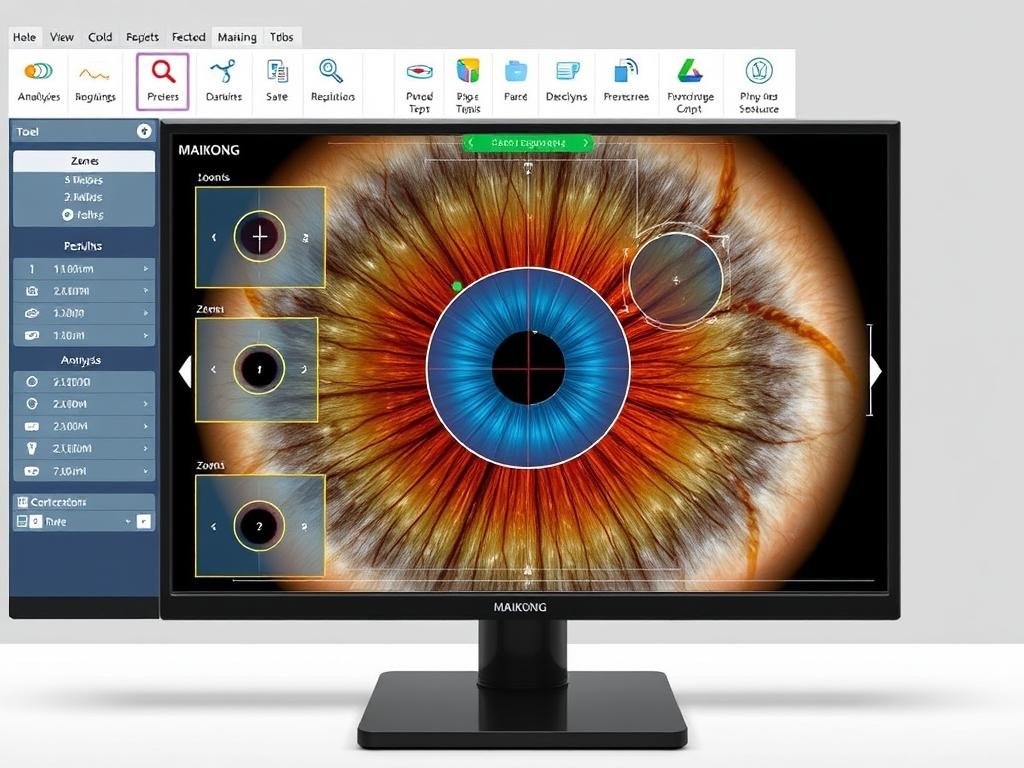
MAIKONG iridology software analyzing iris texture with digital mapping tools. www.iriscope.org
Training and Certification
Professional iridologists typically undergo specialized training to develop their skills:
- Formal education in iridology principles and analysis techniques
- Training in the use of specialized equipment and software
- Study of anatomy, physiology, and basic health sciences
- Certification through recognized iridology organizations
- Continuing education to stay current with advances in the field
With proper training and equipment, iridologists can provide detailed analyses that many clients find valuable as part of a holistic health assessment approach.
MAIKONG: Leaders in Professional Iridology Equipment
With over 20 years of research and manufacturing experience, MAIKONG has established itself as a leading provider of professional iridology equipment. Our commitment to quality, innovation, and customer support has made us the preferred choice for iridology practitioners worldwide.

MAIKONG’s professional iridology equipment lineup including iriscope, camera, and software. www.iriscope.org
Our Product Range
MAIKONG offers a comprehensive range of iridology equipment designed to meet the needs of both beginning and experienced practitioners:
Iriscópio
Our professional-grade iriscopes feature precision optics, adjustable magnification, and ergonomic design for comfortable use during extended analysis sessions.
Câmera de iridologia
MAIKONG iridology cameras combine high-resolution sensors with specialized macro lenses and optimized lighting to capture every detail of the iris texture with exceptional clarity.
Software de iridologia
Our advanced software solutions include image enhancement, analysis tools, chart overlays, and client management features to streamline the iridology workflow.
Iridology Charts
MAIKONG offers detailed iridology reference charts based on various mapping systems to support accurate interpretation of iris signs.
Why Choose MAIKONG
Our commitment to excellence sets us apart in the field of iridology equipment:
4.9
Customer Satisfaction
- Experience: Over 20 years of specialized research and manufacturing expertise
- Quality: Rigorous quality control standards ensure reliable, durable equipment
- Innovation: Continuous improvement and integration of new technologies
- Support: Comprehensive technical support and training resources
- Global Reach: Serving practitioners worldwide with localized support
Enhance Your Iridology Practice with Professional Equipment
Discover how MAIKONG’s professional iridology equipment can help you provide more accurate and comprehensive iris analysis for your clients.
Explore Our Products
Practical Applications of Iris Texture Analysis
Iris texture analysis has applications beyond traditional iridology, spanning from healthcare to security technology.
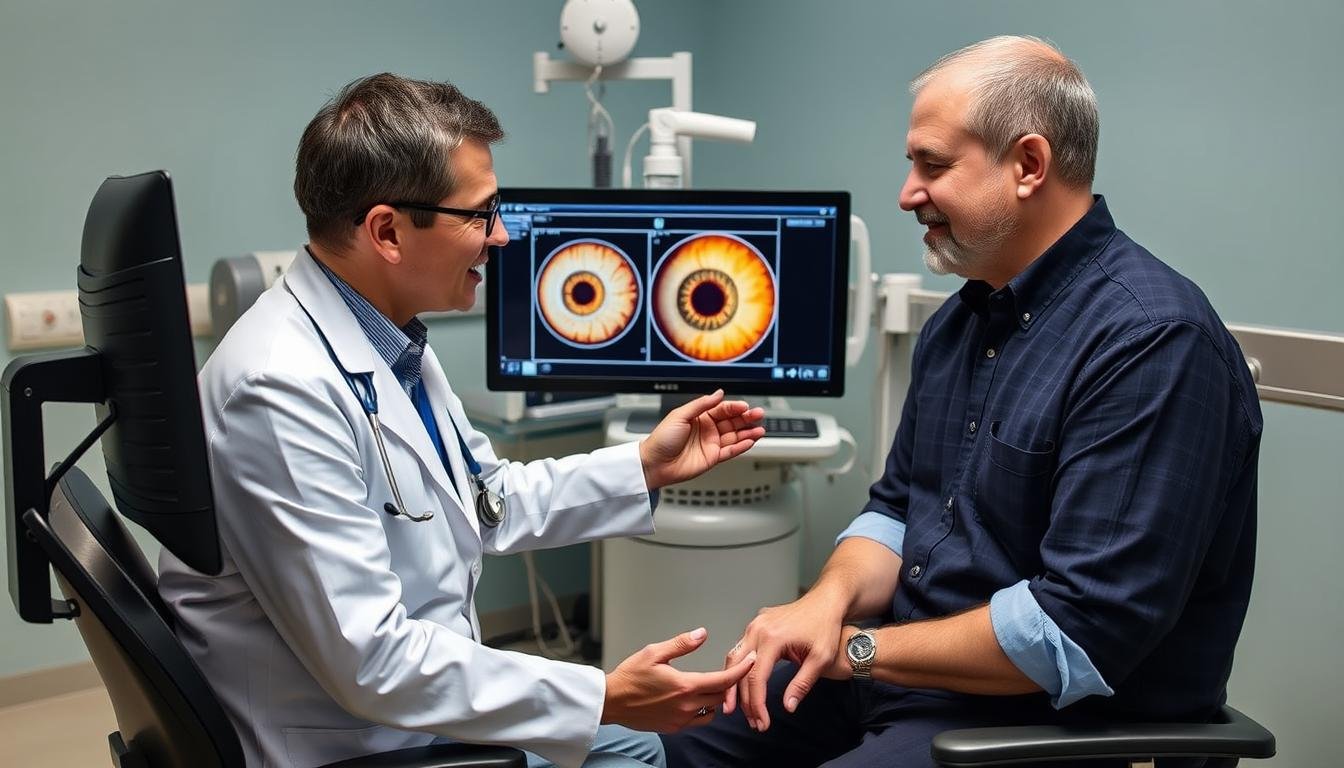
Healthcare practitioner discussing iris analysis results as part of a holistic health assessment. www.iriscope.org
Healthcare Applications
In healthcare settings, iris analysis can serve several purposes:
Avaliação complementar
Iris analysis can complement conventional diagnostic methods by providing additional perspectives on potential health imbalances and constitutional tendencies.
Triagem preventiva de saúde
Some practitioners use iris analysis to identify potential health vulnerabilities before they manifest as symptoms, allowing for preventive interventions.
Monitoring Progress
Sequential iris analysis over time can help track changes that may reflect improvements or deteriorations in health status.
Technological Applications
The unique nature of iris patterns has led to important technological applications:
- Biometric Identification: Iris recognition technology is one of the most accurate forms of biometric identification
- Security Systems: Airports, secure facilities, and even smartphones now use iris scanning for access control
- Medical Research: Analysis of iris patterns across populations helps researchers study genetic and health correlations
- Personalized Medicine: Iris characteristics may eventually contribute to personalized health recommendations
“The iris contains a remarkable wealth of information, not only for identification purposes but potentially as a window into overall health status. As technology advances, we continue to discover new ways to interpret and apply this information.”
– Dr. Jensen, Iridology Researcher
Frequently Asked Questions About Iris Texture
Can iris texture change over time?
The basic structure and pattern of the iris remain relatively stable throughout life. However, certain aspects of iris appearance can change due to aging, health conditions, or environmental factors. These changes typically involve color intensity, pigmentation spots, or the prominence of certain features rather than the fundamental pattern itself.
Is iridology accepted by conventional medicine?
Conventional medicine generally does not recognize iridology as a diagnostic method. However, some healthcare practitioners incorporate it as a complementary assessment tool alongside standard medical practices. The field continues to evolve, with ongoing research exploring potential correlations between iris signs and health conditions.
What equipment do I need to start practicing iridology?
To practice iridology professionally, you would typically need: 1) A high-quality iriscope or iridology camera to capture detailed iris images, 2) Iridology software for analysis and documentation, 3) Reference charts for interpretation, and 4) Proper training and certification. MAIKONG offers complete starter kits that include all necessary equipment for new practitioners.
Can iris texture analysis detect specific diseases?
Iridology is generally not used to diagnose specific diseases but rather to identify potential areas of weakness or imbalance in the body. It provides information about constitutional tendencies and may indicate areas that deserve attention. Always consult with qualified healthcare professionals for medical diagnosis and treatment.
How is iris texture different from iris recognition in security systems?
While both fields study iris patterns, they have different purposes. Iris recognition for security focuses on the unique pattern as a biometric identifier, similar to a fingerprint. Iridology studies iris texture to assess potential health information. However, both fields rely on the fact that iris patterns are highly detailed and unique to each individual.
Conclusion: The Future of Iris Texture Analysis
The study of iris texture continues to evolve, bridging traditional practices with modern technology. As research advances, we may discover even more connections between iris characteristics and health, enhancing the value of this fascinating field.
Whether you’re a healthcare practitioner looking to incorporate iris analysis into your practice or someone interested in exploring this unique approach to health assessment, understanding iris texture provides valuable insights into the complex relationship between our eyes and overall wellbeing.
MAIKONG remains committed to advancing the field of iridology through continuous innovation in equipment design and supporting practitioners with the tools they need for accurate, detailed iris analysis.

























